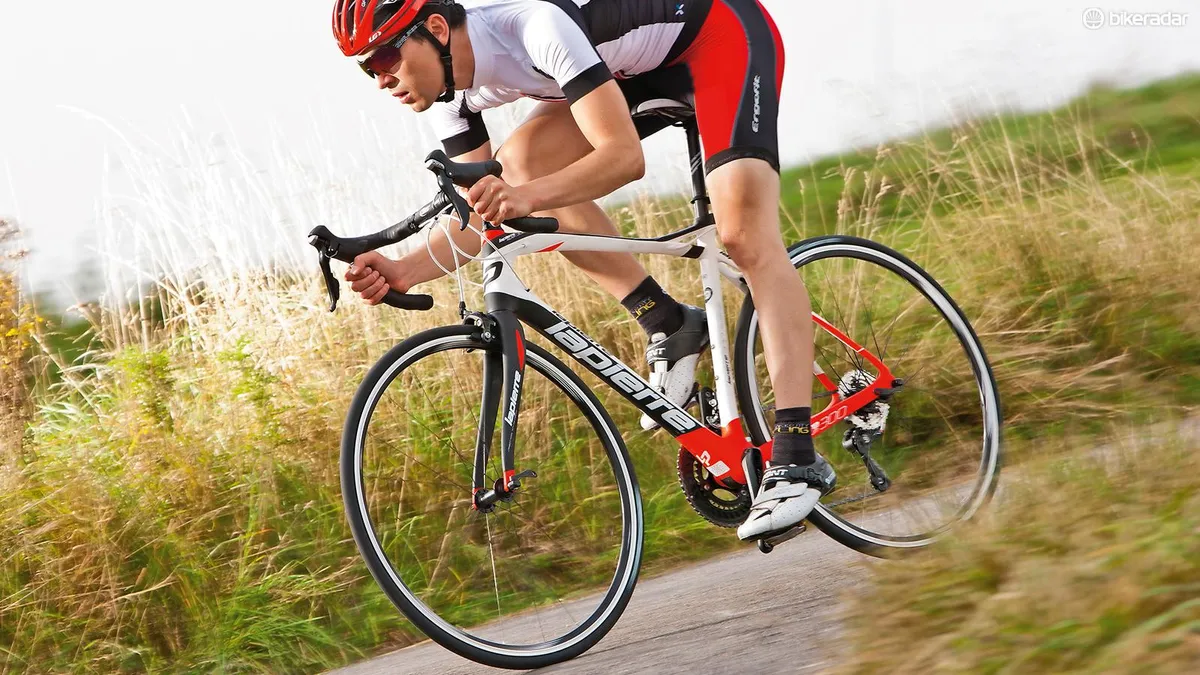One thing that immediately struck us about Lapierre’s Pulsium 300 is that every frame tube looks to have been sculpted and tweaked to a particular shape. To what degree this serves performance rather than aesthetics is debatable, but the result is unique looking, dividing opinion in the BikeRadar office. There are two things that we can all agree on, though: the hidden seat clamp is cool and the matt finish is an absolute nightmare to keep clean.
- Highs: Radical looks, smooth ride
- Lows: Lacklustre wheels, weight
The frame’s arcing toptube splits before meeting the seat tube, the upper strut curving up to the seat clamp area, the lower one interrupted by a plastic sheath that houses the elastomer ring at the core of the bike’s vibration-taming arsenal – more of which later. Lapierre claims further shock absorption from the daintily swept fork, which offers a few more mm of offset than a typical road unit and has a full carbon, tapered steerer. A 27.2mm diameter carbon seatpost completes the comfort-biased picture, topped by a comparatively comfortable Fizik Aliante saddle.

The elastomer offers little flex but may absorb road shock
In aid of stiffness, the seat tube and down tube flare dramatically at the bottom bracket junction, at the heart of which nestles a Shimano press-fit unit.
Ostensibly, Lapierre’s elastomer system bears some resemblance to the cobble-calming IsoSpeed that Trek employs on its Domane line-up, but where Trek’s design decouples the seat-tube from the rest of the frame, the Pulsium’s seat cluster is a single unit with zero degrees of freedom. From road testing, it appears the elastomer adds little in the way of flex to the system, but what it might do is absorb road vibration.
It’s impossible to say how much is down to the frame as a whole and how much is the elastomer, but the Pulsium’s back end soaks up small-bump tarmac buzz quite happily. You’ll still feel impacts from potholes, but poor surfaces aren’t wearing.
Lapierre has another trick up its beautifully tailored French sleeve: the Pulsium’s rear brake caliper is suspended below the seatstay bridge on a curious looking adapter. Remove this, swap in a long-reach caliper, and the maximum tyre size goes from 28 to 32mm. Sadly, there’s no equivalent system up front, but it offers the possibility of buying some extra plushness and grip all the same. The brakes, incidentally, form part of an 11-speed Shimano 105 groupset which provides the class-leading shifting and excellent ergonomics of its more expensive brethren, with just a little less glitz and glamour.

The Pulsium looks great but the matt finish is hard to keep clean
Lapierre claims the Pulsium offers as much lateral stiffness as its Xelius race machine and that may be true, but it isn’t evident from this build. The culprit is the rather basic and weighty Shimano RS010 wheelset; it’s not that the bike lacks get up and go, but under sprint efforts the rear end can’t quite keep up, not helped by the bike’s total weight.
The whole riding experience is one of composure, though, built on conventional geometry, and the tallish head tube (16.5cm) is topped by a tasteful Zipp cockpit, with a 10cm stem keeping reach reasonable and a flared bar offering confident handling.
The Pulsium has some ingenious features, but we aren’t entirely sold on the claims made of the frame. It is a more than pleasant ride, though, and should come alive with better wheels.


